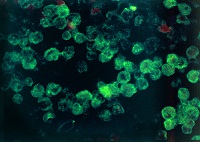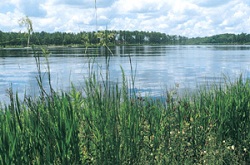We first mentioned this amoeba over a year ago in connection with the death of a woman in Louisiana. Friday, the Louisiana Department of Health and Hospitals (DHH) announced that the microbe had been found in four locations in the St. Bernard Parish water system. The Atlanta based Center for Disease Control (CDC) confirmed the presence of Naegleria fowleri in the public water supply, and all of this follows the death of a 4-year old from infection, back in August. So what is Naegleria fowleri, and what can you do to prevent exposure to this potentially deadly microbe?
 A single cell amoeba, Naegleria fowleri is often found in bodies of warm, freshwater, but can also be found in soil. Typically, it enters the body through the nose. Once deep in the nasal passages, it makes its way to the brain and causes the often fatal disease, primary amebic meningoencephalitis (PAM). Symptoms of PAM can easily be misdiagnosed since the early stages resemble bacterial meningitis, and often can be mistaken for the flu.
A single cell amoeba, Naegleria fowleri is often found in bodies of warm, freshwater, but can also be found in soil. Typically, it enters the body through the nose. Once deep in the nasal passages, it makes its way to the brain and causes the often fatal disease, primary amebic meningoencephalitis (PAM). Symptoms of PAM can easily be misdiagnosed since the early stages resemble bacterial meningitis, and often can be mistaken for the flu.
_The areas where the microbe likes to inhabit does not only include lakes, rivers, ponds and streams. Another potential source is drinking water. If you grew up like I did and have a well, there is potential there for the organism to make an appearance since this water is rarely, if ever, chlorinated. Public water supplies, like those that tested positive in Louisiana, are typically safe if properly chlorinated.  One potential problem, though, is that if not properly monitored and maintained, residual chlorine levels can dip below recommended levels. This opens the door for potential infection, and this is what the CDC found to be the case in this Louisiana parish.
One potential problem, though, is that if not properly monitored and maintained, residual chlorine levels can dip below recommended levels. This opens the door for potential infection, and this is what the CDC found to be the case in this Louisiana parish.
_Overall, the risk of infection is extremely low. Each year, millions swim in lakes, ponds, and streams all across the U.S., but in the last decade, there has been an average of less than four cases a year. When infection does occur, it often makes headlines due to the mortality rate. This can make Naegleria fowleri seem far more common than what it is. Still, there are a few preventative measures you can take to make this low risk, even lower.
- Avoid Getting Water Up Your Nose – Sounds pretty basic right? This means if you're swimming, avoid diving or swimming underwater. You can also wear nose plugs or clips to help prevent this, and it's probably a good idea to keep an eye on the little ones. If they were like me and my brothers when we would play with the garden hose, inhaling water isn't uncommon.
- Keep Swimming Pools Clean – Maintain adequate disinfection, for regular swimming pools – 1-3 ppm of free chlorine and a pH of 7.2 to 7.8.
- If Using A Sinus/Nasal Rinse or Neti Pot – Follow user instructions. Use only distilled or sterile water, which can be readily purchased at just about any grocery or convenience store, or simply boil your water. Tap water is fine for nasal irrigation, if boiled, then cooled, before use.
_
_
_Again, risk of infection is extremely low, and those using public water supplies generally have little to worry about. Risk from showering, cooking or consuming even contaminated water is almost non-existent. Unless you inhale water, it often doesn't make its way deep enough into the nasal passages to prevent any problem, and if consumed, the body's digestive system is more than capable of destroying it.
_And in terms of swimming, if you weren't afraid of the water before, don't be now. Though slightly better odds than being struck by a meteor, risk of infection is pretty low. To put this into perspective, on average just under 40,000 people die a year from drowning. About 3 die a year from Naegleria fowleri.
_In Louisiana, officials are increasing the chlorine in the water supply to not only kill the microbe but to also bring residual chlorine back up to recommended levels.
To see the DHH Press Release or for more information on Naegleria fowleri.
Author: K. Gilmore

Can you get it from inhaling steam I put water on hot pan and quickly water evaporators and i inhale it so it is safe to inhale.
Previous studies have shown that this amoeba is actually fairly well adapted to live in warm environments, even in temperatures as high as 149 degrees F. Now, with that being said, the boiling point of water is 212 deg. F. The CDC recommends that water be boiled for at least one minute, then cooled, prior to use in a device like a neti pot. The temperature of 212 degrees, combined with at least a one minute boil, according to the CDC, is sufficient to kill the pathogen. So I would say, that as long as the water is boiled, it's likely not going to be an issue. You can ask your local physician to be sure.
Can ultrasonic humidifiers can also cause Neglaria. I put tap water in it which is not as clean as yours as we have seen couple of deaths this year from this visit. Please answer.
Tap water in general, not likely. Tap water from any municipality is chlorinated which would kill the amoeba. If you have well water, then I suppose there may be some potential. Though there are features in place to kill microbes, if you are using well water and you are in the southern part of the U.S., you could boil the water or use distilled water to avoid any worry. If you are in the northern part of the U.S., roughly north of 37 degrees latitude, then this shouldn't be a concern as this amoeba can only live in warmer waters.